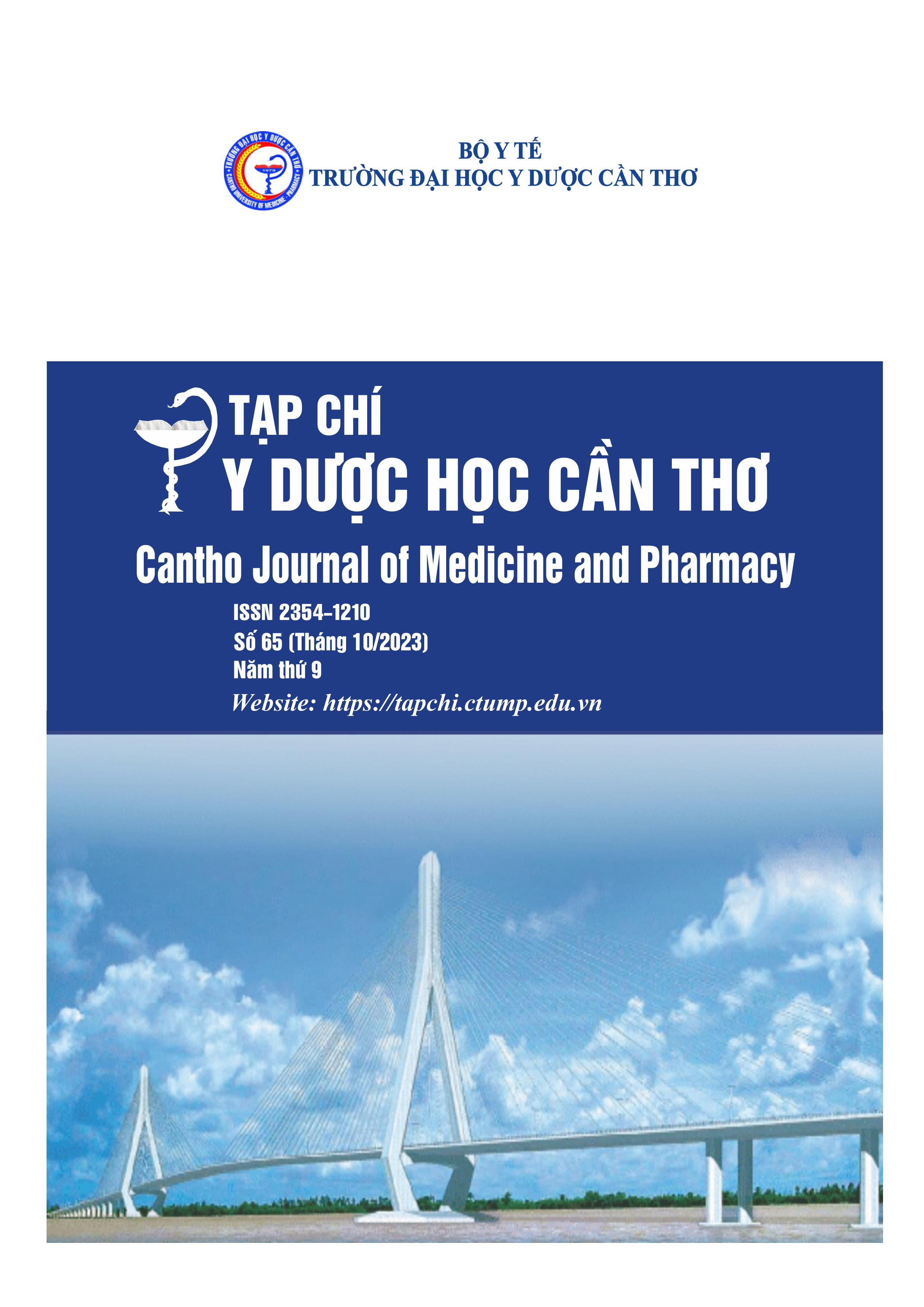APPLICATION OF EU-TIRADS 2017 CLASSIFICATION IN MALIGNANCY RISK STRATIFICATION SYSTEM OF THYROID NODULES AT CAN THO ONCOLOGY HOSPITAL FROM 2021 TO 2023
Main Article Content
Abstract
Background: Thyroid nodules are highly prevalent, with an occurrence of up to 68% in random ultrasound examinations among adults, primarily of benign nature. Early detection of nodules and risk stratification systems (RSS) play a crucial role in guiding their monitoring and treatment. Ultrasound and fine-needle aspiration biopsy (FNAB) are the primary modalities employed in the management of thyroid nodules. Various Thyroid Imaging Reporting and Data Systems (TIRADS) have been developed globally, utilizing ultrasound features such as composition, margin, shape, echogenicity, and echogenic foci. The EU-TIRADS classification system, focusing on key malignant features while ensuring accessibility, has been studied in many countries, including in Vietnam. Objectives: To describe the ultrasound characteristics of thyroid nodules and evaluate their classification using the EU-TIRADS 2017 system, further assessing its correlation with histopathological results. Materials and methods: The study included patients who had ultrasound findings described according to the TIRADS system, underwent surgery, and had histopathological results available. The research employed a cross-sectional descriptive methodology. Results: The analysis of 210 thyroid nodules in 135 patients revealed the following key findings: There was a maleto-female ratio of 1:7, and the average age of the patients was 44 years. The nodules exhibited an average size of 21 mm and commonly displayed features such as a mixed solid and cystic composition, hypoechoic appearance, smooth margins, oval shape, and an absence of echogenic foci. When comparing the EU-TIRADS classification with histopathological results, the distribution of nodules across the EU-TIRADS 2, 3, 4, and 5 categories was 3%, 35%, 29% and 33%, respectively. The corresponding malignancy rates were 0%, 4.3%, 39.7%, and 56%. In terms of diagnostic performance, the EU-TIRADS system demonstrated a high sensitivity, specificity, positive predictive value, negative predictive value, and accuracy of 96%, 81%, 86%, 94%, and 89%, respectively, in effectively distinguishing between benign and malignant nodules. Conclusions: The EU-TIRADS 2017 system proved to be highly valuable in evaluating thyroid nodules, particularly in the TIRADS 5 classification.
Article Details
Keywords
Risk stratification systems (RSS), EU-TIRADS 2017, ACR-TIRADS 2017, thyroid nodules
References
2. Xing, M., et al. (2013), Association between BRAF V600E mutation and mortality in patients with papillary thyroid cancer, Jama. 309(14), 1493-1501.
3. Ross, D.S. (2002), Nonpalpable thyroid nodules—managing an epidemic, The Journal of Clinical Endocrinology Metabolism. 87(5),1938-1940.
4. Trimboli, P. and C. Durante (2020), Ultrasound risk stratification systems for thyroid nodule: between lights and shadows, we are moving towards a new era, Endocrine, tr. 1-4.
5. Hoang, J.K., et al. (2018), Reduction in thyroid nodule biopsies and improved accuracy with American College of Radiology Thyroid Imaging Reporting and Data System, Radiology. 287(1), tr. 185-193.
6. Castellana, M., et al. (2020), Performance of EU-TIRADS in malignancy risk stratification of thyroid nodules: a meta-analysis, European Journal of Endocrinology. 183(3), tr. 255-264.
7. Haugen, B.R., et al. (2016), 2015 American Thyroid Association management guidelines for adult patients with thyroid nodules and differentiated thyroid cancer: the American Thyroid Association guidelines task force on thyroid nodules and differentiated thyroid cancer, Thyroid. 26(1), tr. 1-133.
8. Russ, G., et al. (2017), European Thyroid Association guidelines for ultrasound malignancy risk stratification of thyroid nodules in adults: the EU-TIRADS, European Thyroid Journal. 6(5), tr. 225-237.
9. Xiao, F., et al. (2023), Multimodality US versus Thyroid Imaging Reporting and Data System Criteria in Recommending Fine-Needle Aspiration of Thyroid Nodules, Radiology. 307(5).
10. Molina-Vega, M., et al. (2019), Clinical and Ultrasound Thyroid Nodule Characteristics and Their Association with Cytological and Histopathological Outcomes: A Retrospective Multicenter Study in High-Resolution Thyroid Nodule Clinics, Journal of Clinical Medicine. 8(12), tr. 2172.
11. Kovatcheva, R.D., et al. (2021), Evaluation of the diagnostic performance of EU-TIRADS in discriminating benign from malignant thyroid nodules: a prospective study in one referral center, European Thyroid Journal. 9(6), tr. 304-312.
12. Xu, T., et al. (2019), Validation and comparison of three newly-released Thyroid Imaging Reporting and Data Systems for cancer risk determination, Endocrine. 64, tr. 299-307.
13. Skowrońska, A., et al. (2018), Accuracy of the European Thyroid Imaging Reporting and Data System (EU-TIRADS) in the valuation of thyroid nodule malignancy in reference to the postsurgery histological results, Polish Journal of Radiology. 83, tr. 577-584.
14. Hekimsoy, I., et al. (2021), Diagnostic performance rates of the ACR-TIRADS and EUTIRADS based on histopathological evidence, Diagnostic and Interventional Radiology. 27(4), 511.


